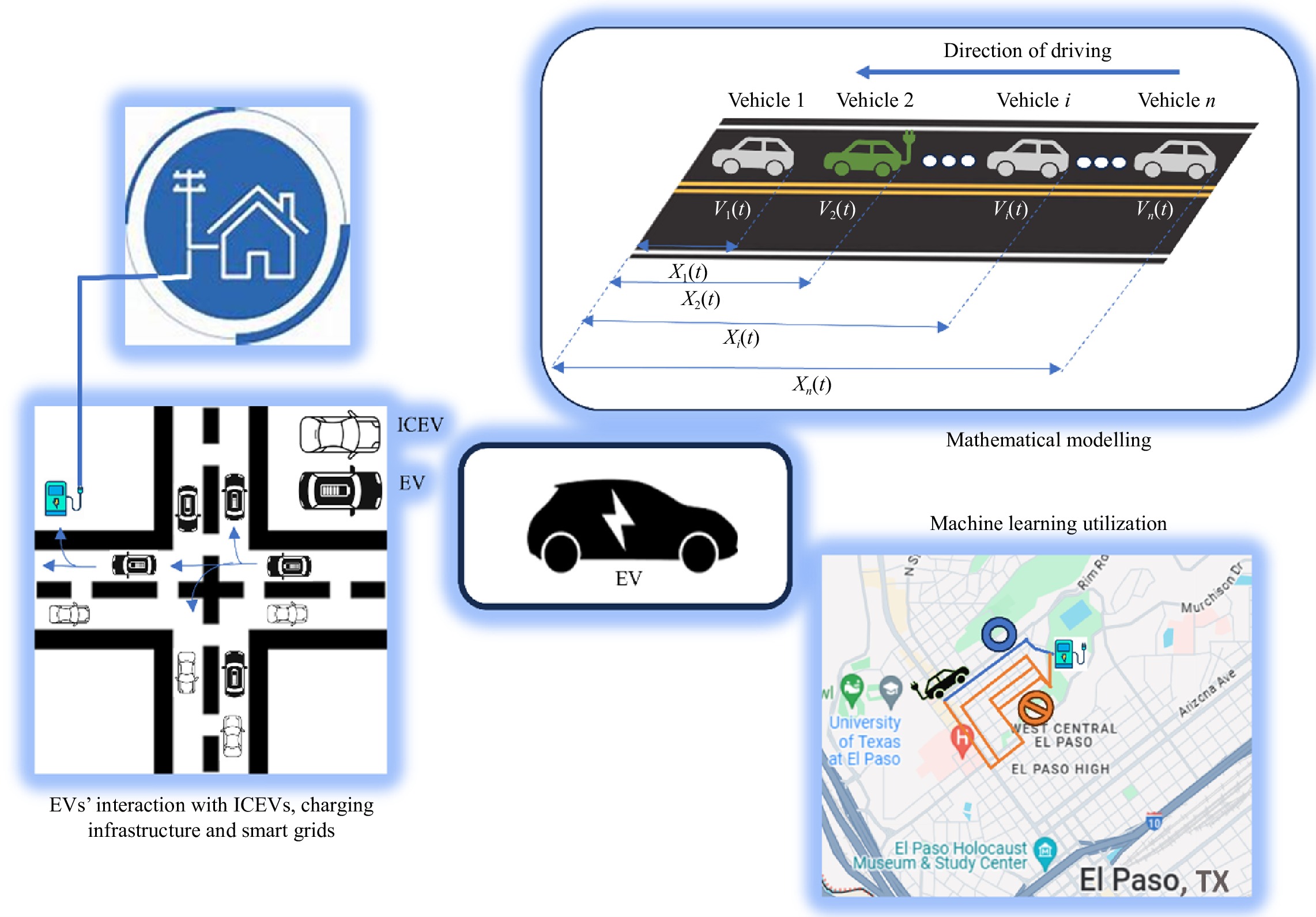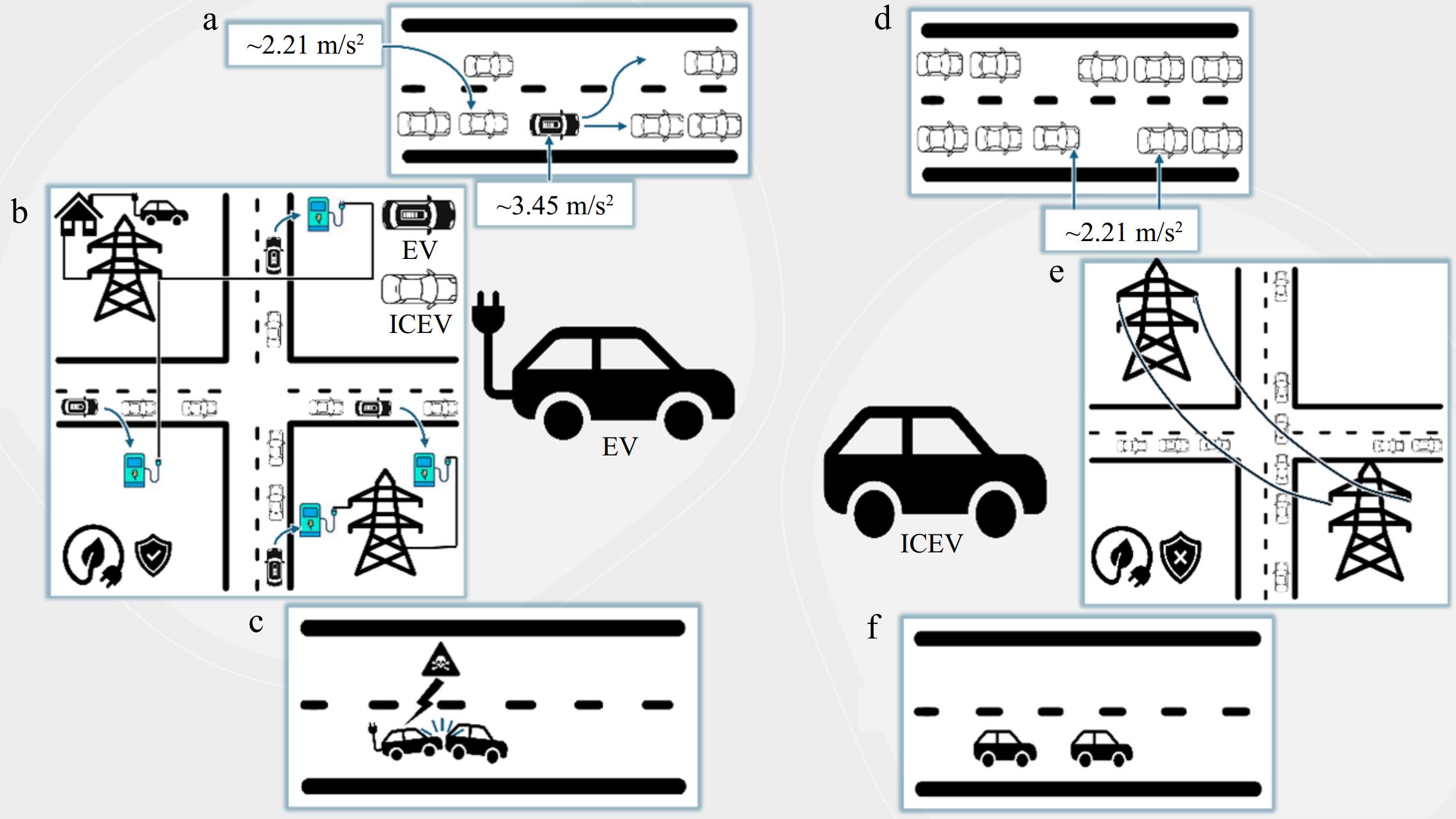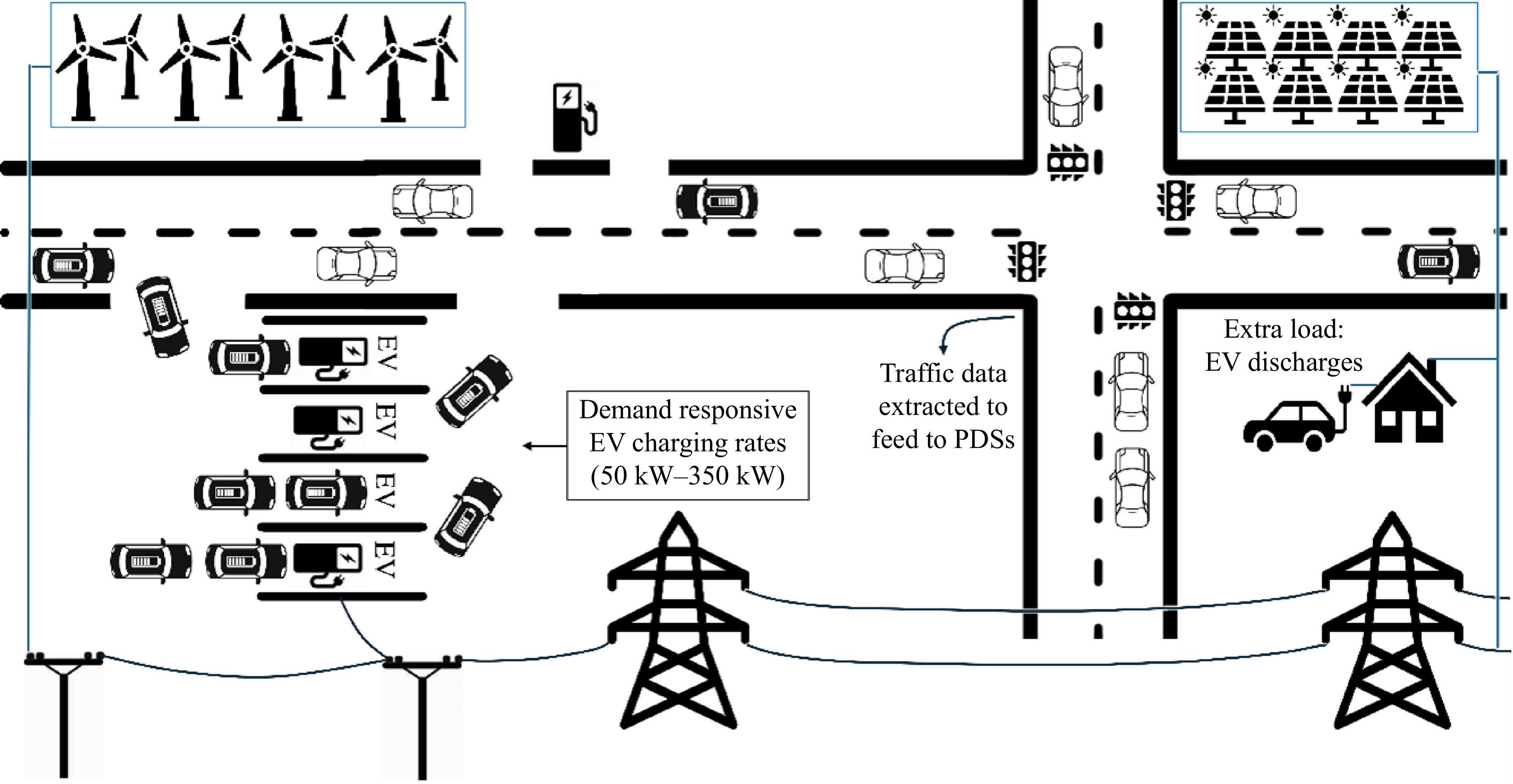-

Figure 1.
The increasing adoption of EVs can pose challenges on the existing transportation network. These stem from discrepancies in acceleration/deceleration patterns of EVs and ICEVs, disparities between charging station demands and grid supplies, or even from the cybersecurity of EVs' internal communication and external communication with charging stations and local grids. The figure on the left shows possible decision-making points of EVs while being part of a smart grid network. The figure on the top right illustrates a car-following scenario involving EVs based on mathematical modeling. The figure on the bottom right demonstrates a hypothetical case of ML application in determining the optimal route to a charging station.
-

Figure 2.
Illustration of the comparative impacts that EVs and ICEVs have on the transportation system. (a) shows two hypothetical values for the accelerations of EVs and ICEVs. The higher acceleration value of EVs enables them to quickly catch up with the vehicle in front during stop-and-go traffic, facilitating traffic smoothing. In contrast, ICEVs, with their comparatively slower acceleration, take longer to catch up (d), leading to ripple effects in traffic wave propagation. (b) illustrates how EVs, through their integration into smart grids and optimal allocation of charging stations, may impact the equilibrium distribution of vehicles on the road (compared to (e)). The leaf connected to an electric plug symbol indicates that this approach is environmentally friendly by accommodating renewable energy sources and reducing carbon emissions. While EVs offer certain benefits to the transportation system, they may be more vulnerable to cyber threats, such as CAN bus attacks and false data injection attacks, compared to ICEVs (c) and (f), which requires additional safety precautions.
-

Figure 3.
Illustration of the interactions between power systems and transportation networks, with a primary focus on EVs. Acting as mobile energy storage devices, EV integration into power grids can accommodate the uncertainty of renewable energy sources (RES) such as solar and wind. This stored energy can be fed back to the power grid during peak energy demands through V2G technology, thereby facilitating grid stability. Additionally, charging stations can contribute to grid stability by regulating the charging rates of EVs in a demand-responsive manner. Furthermore, integrating traffic network data with power distribution network data can optimize FCS allocation and route planning, as well as dynamically adjust charging schedules to reduce congestion.
-
Acronym Full form QoE Quality-of-Experience SoC State-of-Charge SoH State-of-Health ACC Adaptive Cruise Control ADAS Advanced Driver Assistance System CAN Controller Area Network DQN Deep-Q-Network DRL Deep Reinforcement Learning EV Electric Vehicle FCS Fast Charging Station GCN Graph Convolutional Network GPS Global Positioning System ICEV Internal Combustion Engine Vehicle MDP Markov Decision Process ML Machine Learning MPR Market Penetration Rate PDS Power Distribution System RES Renewable Energy Source RL Reinforcement Learning V2G Vehicle-to-Grid Table 1.
List of acronyms.
-
Study Impact/concern presented Solution proposed (in case of negative impacts) Zare et al.[6] The differences in acceleration/deceleration patterns between EVs and ICEVs in stop-and-go traffic lead to disruptions[6]. Proposed the EVM car-following model to better assess the EV-ACC behavior in those traffic scenarios, creating future research opportunities to mitigate the disruption[6]. Wang et al.[2],
Zhang et al.[31]Whether in a mixed EV or all-EV scenario, congestion during morning commuting persists[2]. Staggering the arrival times of EVs, or implementing an optimal tolling paradigm, can help alleviate or eliminate congestion[2]. Fluctuations in congestion and degradation of traffic safety occurs only at higher EV MPRs[31]. Increased EV penetration reduces congestion and improves safety at critical density levels[31]. Zhou et al.[8] The integration of EVs and smart grids significantly affects traffic dynamics by altering charging patterns and road availability[8]. Dynamic pricing based on hourly forecasts of traffic flow and RES generated energy can reduce traffic congestion during both peak and off-peak hours[34]. Mishra et al.[11],
Rizvi et al.[12],
Tang & Wang[35],
Chen et al.[36]Increased EV charging demand leads to higher congestion levels and nodal voltage deviations[35]. Nodal time-of-use pricing and traffic congestion pricing can be used to dynamically shift EV loads[35]. Congestion near charging stations may persist even with V2G due to uneven station distribution or off-peak charging demand[35]. EVs can act as mobile energy storage for RES and supply energy to the grid during peak hours, thereby alleviating excess demand[12]. EV charging can facilitate load balancing by transferring energy among power grids[36]. Large-scale V2G adoption can promote off-peak charging and peak-hour discharging, potentially alleviating congestion by altering the availability of cars on the road[11]. Avatefipour et al.[39], Acharya et al.[40],
Dey & Khanra[41],
Gunduz & Das[45]CAN bus attacks[39] can cause accidents; false data injection attacks can manipulate vital information such as battery health or charging status[40,41,45]. ML model for CAN bus anomaly detection[39]. Algorithms combining system dynamics knowledge with measurements[41]. Table 2.
Impacts of EVs, EV-grid integration, and their cybersecurity on transportation systems.
-
Study Model Main ideas Xu et al.[17] EV Behavioral Model To consider the unique acceleration and deceleration patterns of EVs to better understand their behavior in congested traffic. Sebai et al.[18] EV Route Planning with Real-Time Traffic Prediction To use real-time data, such as incidents and congestion, along with road features like slopes, to optimize routes for EVs. Li et al.[48] By-Level Dynamic Charging Scheduling Model To utilize real-time traffic data and day-ahead power system scheduling to optimize EV charging schedules, thereby efficiently managing charging loads and reducing wait times. Guler[10],
Yang et al.[19]Optimal FCS Allocation and Sizing Model[10] To use a queueing algorithm to determine the optimal FCS size that maximizes EV user satisfaction and station utilization while reducing user wait times[10]. Traffic-Aware Joint Planning Model for FCS[19] To improve on the study by Guler[10] by integrating traffic network data into a combined planning model for PDS and FCS to efficiently balance traffic flow and reduce congestion[19]. Liu et al.[20],
Karaaslan et al.[21]Pedestrian Traffic Safety Models[20,21] Liu et al.[20] used a logistic regression model to analyze factors such as pedestrian traffic and road type, finding that EVs, due to their quiet operation, are 31.5% more likely to collide with pedestrians or cyclists. Karaaslan et al.[21], using a simulation model, concluded that EVs are at a 30% higher risk of colliding with pedestrians in noisy environments and a 10% higher risk in quieter environments, compared to ICEVs. Zare et al.[6] Electric Vehicle Model To better assess the EV-ACC behavior in stop-and-go traffic and ultimately to mitigate the disruptions using these vehicles. Ozkan et al.[51] Green Wave Control Model To anticipate road traffic, regulate vehicle speed within a predetermined range, and ultimately reduce energy usage while extending the range of EVs. He et al.[52] Real-Time Traffic Prediction Model To consider the impacts of lane changing on the evolution of traffic states to optimally control the speeds of EV eco-driving to maximize energy efficiency. Li et al.[53] Communication-Efficient Distributed Pricing Model[53] To account for uncertainties in RES while simultaneously distributing power and pricing, and managing traffic flow assignments[53] Čičić &
Canudas-De-Wit[54]EV Virtual Power Line Model[54] To dynamically adjust charging prices and rates at charging stations based on the concept of virtual power lines for EVs[54]. Li et al.[55] Reliability Evaluation Model To accurately describe the spatiotemporal characteristics of PDS that incorporate microgrids to facilitate the integration of EVs into vehicle-sharing networks. Table 3.
Traffic flow models to address emerging questions and concerns related to EVs.
-
Study ML model used Purpose of the model used Basso et al.[58,59] Bayesian Model[58] To predict energy consumption variations across different route choices, enabling the most efficient selection of routes that offer lower energy consumption and increased reliability[58]. Safe Reinforcement Learning (SRL)[59] To solve the dynamic stochastic EV routing problem through offline learning of stochastic customer requests and energy consumption, allowing for predictive and safe online route planning that minimizes energy usage and prevents battery depletion[59]. Lin et al.[60] Deep Reinforcement Learning (DRL) To solve the EV routing problem with time windows for commercial EV fleets. Jin et al.[23] Deep Q-Network (DQN) To effectively handle large-scale complex traffic network data and to facilitate the application of Markov decision processes in route planning problems. Li et al.[63] Graph Convolutional Network (GCN) To predict charging demand and optimize charger placement and resource allocation strategies while taking into account the market the market penetration of EVs. Zhang et al.[64] Density-Based Spatial Clustering of Applications with Noise (DBSCAN) and Artificial Neural Network (ANN) To facilitate charging infrastructure planning and scheduling through urban charging load forecasting, considering trip patterns and network characteristics. Mohammad et al.[61], Golsefidi et al.[24], Abdalrahman & Zhuang[66],
Chen et al.[67]Convolutional long short-term memory (ConvLSTM), Bidirectional ConvLSTM, and Gaussian Process Regression (GPR) To capture spatio-temporal features in energy demand data from charging stations across cities and to predictively expand EV charging infrastructure. Praveena et al.[27] Artificial Neural Network (ANN) To accurately predict an EV's SoC[27]. Yang et al.[69] To estimate SoH using data directly extracted from EV batteries[69]. Chaoui et al.[68] Deep Reinforcement Learning (DRL) To optimize battery health in EVs by strategically managing the SoC of multiple energy storage devices to extend battery lifespan. Table 4.
Machine learning applications for optimizing EV integration into transportation networks.
Figures
(3)
Tables
(4)